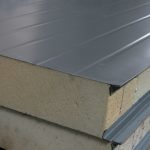A wet facade is a type of exterior decoration of the walls of the house, to create an insulating layer. Today, this technology is actively used not only in private construction, but also in the decoration of multi-apartment buildings. The material got its name due to the fact that all building components interact with each other due to the main binder - water. We can say that a wet facade is not a separate material, but a complex of heaters. Let us consider in more detail what it is.

A wet facade has several varieties. They are divided by the composition of the materials present. Here are the most common ones:
- Facades with an organic structure. As an insulating material, foam polystyrene acts here. The reinforcing coating contains only organic substances. As a top coat, an organic or silicone plaster mix is used;
- Facades with a mineral structure. The insulation material is mineral wool. The reinforcing coating has a mineral structure. As a finishing plaster, use silicone or mineral mixtures;
- Combined facades. In this case, both insulation technologies are used. At the same time, the thickness of the material layer does not increase, and the quality characteristics increase significantly.

The main advantages of wet facades
Using technology of the wet facade, you can create an excellent insulating coating at home, which will not only effectively retain heat in the interior, but also create additional soundproofing.

The cost of materials and work will cost much less when compared with other types of insulation. Today, a wet facade is considered the most economical, but extremely effective technology.

Another important advantage of the material is its low weight. That is, the insulation does not need additional strengthening after application to the surface.

Wet facades have a fairly long service life. They will not require serious repairs for 30 years. If there is a desire, it is enough to simply change the color of the facade by means of painting the plaster surface.

-
 What you need to know when designing a half-timbered house
What you need to know when designing a half-timbered house
-
 The better to close the gaps between the walls and the ceiling in a wooden house
The better to close the gaps between the walls and the ceiling in a wooden house
-
 Attic floor insulation
Attic floor insulation
-
 The consequences of errors when knitting reinforcing bars
The consequences of errors when knitting reinforcing bars
-
 Why it is impossible to mount tongue-and-groove plates without elastic laying
Why it is impossible to mount tongue-and-groove plates without elastic laying
-
 Why you can not immediately walk on the laminate after laying
Why you can not immediately walk on the laminate after laying
-
 What is the difficulty of installing roof sandwich panels
What is the difficulty of installing roof sandwich panels
-
 Condensation on the sandwich panels due to installation errors
Condensation on the sandwich panels due to installation errors
-
 Is it possible to build a house alone
Is it possible to build a house alone
-
 Typical errors when installing wall panels
Typical errors when installing wall panels
-
 Wooden carport: pros and cons
Wooden carport: pros and cons
-
 What causes a violation of the temperature regime when laying brick
What causes a violation of the temperature regime when laying brick
New publications are published daily on our channel in Yandex. Zen
Go to Yandex. Zen


